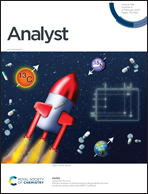An electrochemiluminescence aptasensor based on highly luminescent silver-based MOF and biotin–streptavidin system for mercury ion detection†
Abstract
In this study, for the first time, a silver-based metal–organic framework (Ag-MOF) was synthesized and used as the electrochemiluminescence (ECL) emitter for building an ECL sensor. After modification with chitosan (CS) and gold nanoparticles (Au NPs), the ECL stability of Ag-MOF was improved. To detect mercury ions, a biosensor was constructed using the mercury ion aptamer and steric effect of streptavidin. First, the capture strand (cDNA) with terminal-modified sulfhydryl group was attached to the electrode surface by the Au–S bond. Then, the mercury-ion aptamer (Apt-Hg) modified with biotin was anchored to the electrode by complementary pairing with cDNA. Streptavidin (SA) could be fixed on the electrode by linking with biotin, thereby reducing the ECL signal. However, in the presence of mercury ions, the aptamer was removed and streptavidin could not be immobilized on the electrode. Hence, the ECL signal of the sensor increased with the concentration of mercury ions, which was linear in the range from 1 μM to 300 fM. The detection limit could reach 66 fM (S/N = 3). The sensor provided a new method for the detection of mercury ions.

- This article is part of the themed collection: Analyst HOT Articles 2023


 Please wait while we load your content...
Please wait while we load your content...